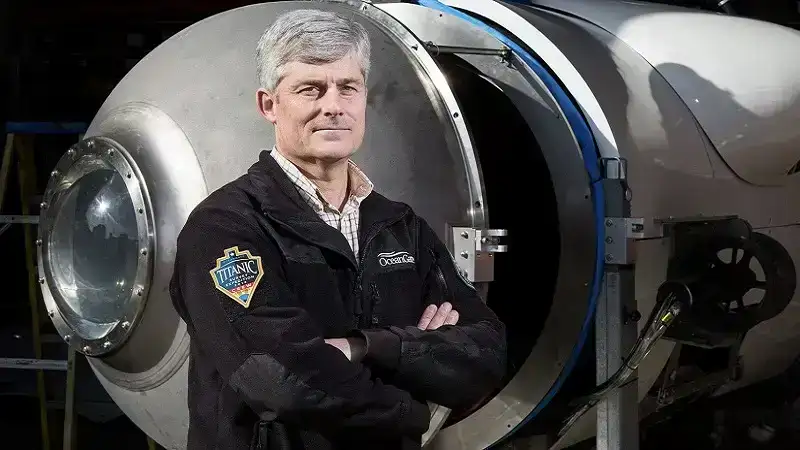Stockton Rush was a visionary entrepreneur, engineer, and deep-sea explorer renowned for his groundbreaking contributions to underwater exploration. As the founder and CEO of OceanGate, he played a pivotal role in revolutionizing submersible technology, developing cutting-edge vessels designed for deep-sea expeditions. His relentless pursuit of innovation and dedication to marine exploration propelled his company to the forefront of the industry. Over the years, his business ventures, technological advancements, and leadership significantly influenced Stockton Rush net worth. This article explores Stockton Rush financial status, career milestones, and the key factors that contributed to his wealth and lasting legacy.
Early Life and Background
Stockton Rush was born on March 31, 1962, in San Francisco, California, United States. Raised in a family with a distinguished background in aviation and engineering, he was exposed to the world of innovation and technology from an early age. His parents, Ellen Rush and Richard Stockton Rush Jr., recognized his natural curiosity and nurtured his passion for scientific discovery, encouraging him to set ambitious goals and push the limits of what was possible. Growing up in an environment that valued creativity, exploration, and cutting-edge advancements, he developed a profound interest in both aerospace and marine technology.
He was particularly fascinated by the possibilities of deep-sea and space exploration, believing that engineering could unlock new frontiers. This strong foundation ultimately led him to pursue a career dedicated to revolutionizing deep-sea travel, designing advanced submersibles, and pioneering innovations in underwater exploration. His relentless drive to push the boundaries of technology defined his legacy in the field of deep-sea engineering.
Stockton Rush Biography
| Category | Details |
|---|---|
| Full Name | Richard Stockton Rush III |
| Date of Birth | March 31, 1962 |
| Place of Birth | San Francisco, California, United States |
| Date of Passing | June 18, 2023 |
| Age at Passing | 61 years |
| Cause of Death | Implosion of the Titan submersible |
| Nationality | American |
| Education | – Princeton University (Aerospace Engineering) – University of California, Berkeley |
| Parents | Ellen Rush, Richard Stockton Rush Jr. |
| Marital Status | Married |
| Children | 2 |
| Career | Entrepreneur, Engineer, and Deep-Sea Explorer |
| Notable Role | Founder & CEO of OceanGate Inc. |
| Company Founded | OceanGate (2009) |
| Major Achievement | Development of innovative submersibles for deep-sea exploration |
| Key Vessel | Titan Submersible |
| Revenue Sources | – OceanGate operations – Submersible manufacturing – Sponsorships & partnerships – Media & documentary features |
| Estimated Net Worth | $12 million |
| Impact on Industry | Pioneered new approaches in deep-sea tourism and exploration |
| Legacy | Contributions to underwater technology and deep-sea research |
Age and Death
Stockton Rush passed away on June 18, 2023, at the age of 61. His death occurred in the Atlantic Ocean during a deep-sea expedition to explore the wreckage of the Titanic. Rush, who was the CEO of OceanGate and a pioneer in deep-sea tourism, was aboard the Titan submersible when it suffered a catastrophic implosion. The tragedy resulted in the loss of all five individuals on board, including Rush himself. This devastating incident not only shocked the world but also raised critical concerns about the safety and regulations surrounding underwater exploration and deep-sea tourism. Experts and investigators have since analyzed the accident to determine the exact causes and potential lapses in safety protocols. His passing marked a significant moment in maritime history, leading to discussions on the risks associated with deep-sea travel and the necessity for improved engineering standards in submersible technology.
Height and Weight
Stockton Rush stood at approximately 5 feet 10 inches (178 cm) tall, an average height for men in his age group. He maintained a healthy weight of around 75 kg (165 lbs), reflecting his active lifestyle. As an experienced pilot, engineer, and deep-sea explorer, he prioritized physical fitness, recognizing its importance for his demanding work. His profession required endurance and adaptability, whether he was piloting aircraft, leading underwater expeditions, or participating in hands-on engineering work. His dedication to exploration and innovation kept him engaged in physically and mentally rigorous activities throughout his career.
Education
Stockton Rush had a strong educational foundation in engineering, which played a key role in shaping his career as an innovator. He attended Princeton University, where he earned a degree in aerospace engineering. His studies focused on advanced mechanics, physics, and vehicle design, providing him with the technical expertise needed for a career in exploration.
After completing his undergraduate degree, he continued his education at the University of California, Berkeley, further expanding his knowledge in engineering and technology. Initially, his aerospace training positioned him for a career in space exploration. However, over time, his passion shifted toward deep-sea technology. He saw the uncharted depths of the ocean as a new frontier, much like outer space, and dedicated his life to pioneering advancements in underwater exploration. His education provided the foundation for his work with OceanGate, where he applied his engineering skills to develop state-of-the-art submersibles.
The Establishment of OceanGate
In 2009, Stockton Rush co-founded OceanGate, a company dedicated to developing advanced submersibles for deep-sea exploration. The company’s primary mission was to provide manned submersibles for research, commercial, and adventure purposes. Rush was passionate about making deep-sea exploration more accessible and believed that technological advancements could open new frontiers for humanity.
OceanGate developed several submersibles under Rush’s leadership, with Titan becoming one of the most well-known. Titan was designed to withstand extreme ocean depths, particularly for missions to the Titanic wreck site. The success of OceanGate contributed significantly to Stockton Rush’s net worth, as the company attracted investors and clients from across the globe.
Family Life and Personal Background

Stockton Rush was married to Wendy Rush, who shared his passion for deep-sea exploration. Actively involved in OceanGate, she supported his mission and contributed to his vision. The couple had two children. His parents, Ellen Rush and Richard Stockton Rush Jr., provided him with a strong educational foundation and nurtured his interest in science and technology. Their encouragement played a crucial role in shaping his career, offering both financial and emotional support throughout his journey.
Despite his deep dedication to his work, Rush always prioritized family. His wife and children stood by his side, supporting his passion for deep-sea exploration, even though his career involved considerable risks. The strong bond he shared with his family greatly influenced his life and decision-making.
Rush early upbringing and family background instilled in him a love for adventure and discovery. His parents played an essential role in fostering his curiosity and drive for innovation, ultimately leading him to pursue a career in oceanic and aerospace technology.
Revenue Streams Contributing to Stockton Rush Net Worth
Several factors played a crucial role in building Stockton Rush wealth. His primary sources of income included:
- OceanGate Operations – The company offered deep-sea expeditions, scientific research collaborations, and underwater construction services.
- Submersible Manufacturing – OceanGate developed and sold innovative underwater vessels, attracting investors and scientific institutions.
- Sponsorships and Partnerships – Collaboration with various organizations and sponsors helped fund OceanGate’s missions.
- Media and Documentary Appearances – Stockton Rush’s deep-sea exploration efforts were featured in documentaries and media programs, adding to his financial success.
- Public Speaking and Advocacy – Rush often spoke at conferences and industry events, sharing his vision for deep-sea exploration and generating interest in OceanGate’s technology.
Stockton Rush Net Worth
Stockton Rush net worth was around $12 million at the time of his death. His wealth primarily came from his career in oceanic technology and his role as the CEO of OceanGate. He secured funding from investors and clients who were interested in deep-sea tourism. Additionally, his work in aviation and engineering also contributed to his financial success.
Despite his fortune, much of his wealth was reinvested into research and development. He was more focused on advancing technology than accumulating personal wealth. Stockton Rush net worth reflected his dedication to innovation, as he continuously sought ways to improve underwater exploration.
The Risks and Challenges of Deep-Sea Exploration
Stockton Rush’s passion for underwater exploration came with inherent risks. The deep-sea industry requires significant investment in research, technology, and safety measures. OceanGate’s projects often faced financial and technical challenges, impacting profitability. Despite these hurdles, Stockton Rush remained committed to pushing the boundaries of deep-sea travel.
One of the most significant challenges Rush faced was ensuring the safety and durability of OceanGate’s submersibles. Deep-sea exploration involves extreme pressure and unpredictable conditions, making it a highly complex field. Critics and experts occasionally raised concerns over the safety protocols employed by OceanGate, but Rush remained steadfast in his belief that innovation required taking risks.
Tragic Incident and Its Impact on Financial Legacy
On June 18, 2023, Stockton Rush was aboard Titan, the OceanGate submersible that tragically imploded during an expedition to the Titanic wreck site in the Atlantic Ocean. The incident led to significant media scrutiny, legal investigations, and financial consequences for OceanGate. He was 61 years old at the time of his passing.
The tragedy deeply affected the industry and raised questions about the future of commercial deep-sea exploration. Following Rush’s death, OceanGate faced lawsuits and financial difficulties, further impacting his overall net worth. Despite the controversy surrounding the incident, many industry experts acknowledged Rush’s contributions to underwater exploration.
Stockton Rush Impact on Underwater Exploration
Despite financial ups and downs, Stockton Rush revolutionized deep-sea exploration. His dedication to innovation inspired future generations of engineers and explorers. While his personal net worth may have fluctuated, his work continues to influence the industry.
Rush’s vision for affordable and accessible deep-sea exploration remains relevant today. His efforts paved the way for future advancements in submersible technology, inspiring scientists, engineers, and adventurers to continue exploring the unknown depths of the ocean. His legacy lives on in the technological advancements he championed and the bold vision he pursued.
Hobbies and Interests
Stockton Rush had a deep passion for exploration, technology, and innovation, which shaped his hobbies and personal interests. Throughout his life, he engaged in activities that aligned with his adventurous spirit and engineering mindset.
- Aviation – As a licensed pilot, Rush had a lifelong love for flying. He often spent his free time piloting aircraft, finding excitement in the mechanics and freedom of flight. His interest in aviation played a crucial role in shaping his perspective on vehicle design and safety, influencing his later work with submersibles.
- Engineering – Rush was fascinated by technology and dedicated much of his time to designing and developing innovative systems. His expertise in engineering extended beyond marine exploration, encompassing various areas of transportation and structural design. He was always seeking ways to improve technology and make exploration safer and more efficient.
- Deep-Sea Exploration – He was fascinated by the mysteries of the deep ocean. He worked tirelessly to advance submersible technology. His goal was to make deep-sea exploration accessible to researchers and tourists.
- Space Exploration – Although his career was focused on the depths of the ocean, Rush was also deeply intrigued by the cosmos. He frequently drew comparisons between space and deep-sea travel, noting the similarities in their extreme environments and technological challenges. His enthusiasm for space exploration led him to collaborate with experts in the field and stay informed about advancements in astronautics.
- Travel and Adventure – Rush had an insatiable curiosity about the world and loved to explore remote, challenging environments. Whether traveling to isolated regions or testing new technology in extreme conditions, he sought adventure in every aspect of his life. His drive to reach unexplored frontiers was a defining characteristic of his personality and career.
Lessons from Stockton Rush Life and Career
Stockton Rush journey as an entrepreneur and innovator offers several key insights and lessons:
- Innovation Requires Risk – Throughout his career, Rush demonstrated a willingness to take risks to push the boundaries of deep-sea exploration. He believed that progress often comes with uncertainty and was determined to pioneer advancements despite the challenges.
- Financial Success is Not Always Linear – Rush experienced fluctuations in his net worth due to the unpredictable nature of the exploration industry. However, his unwavering dedication to his vision ensured that he remained focused on long-term success rather than short-term financial gains.
- Legacy is More Than Wealth – While Rush achieved financial success, his true impact was in the advancements he made in ocean exploration. His contributions to the field and his efforts to open new opportunities for deep-sea discovery define his lasting legacy.
- Entrepreneurship Requires Resilience – Rush faced numerous obstacles, from technical setbacks to financial struggles, but his perseverance allowed him to keep OceanGate moving forward. His story serves as a testament to the determination and resilience required to turn ambitious ideas into reality.
Ultimately, Stockton Rush’s life was marked by his relentless pursuit of innovation and discovery. His legacy lives on in the advancements he brought to deep-sea exploration and the inspiration he provided to future explorers.</p>
Conclusion
Stockton Rush net worth was a reflection of his commitment to innovation and pushing the boundaries of human exploration. As the founder and CEO of OceanGate, he played a crucial role in developing advanced submersible technology, aiming to make deep-sea exploration more accessible to researchers and adventurers. His work contributed significantly to oceanography, maritime archaeology, and adventure tourism, allowing people to witness the mysteries of the deep firsthand.
Despite financial ups and downs, Rush remained dedicated to his mission, prioritizing exploration over monetary gain. His tragic passing in the Titan submersible disaster does not overshadow his legacy. His pioneering efforts in underwater exploration continue to inspire scientists, engineers, and explorers who share his passion for uncovering the ocean secrets. Read More borncyan.
